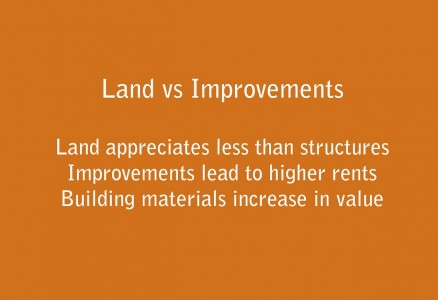 Land is a primary asset, part of many, though not all, income property purchases. But land and the structures on that land are often not the same. King Solomon of Old Testament fame understood the relationship between land and structures, as he increased his holdings in what has been called the greatest kingdom of his time. And at the same time, he set in motion projects – vast, sweeping enterprises such as the great temple, which in all its glory was made possible by the land, but also by the materials which contributed to the making of that temple and the other wondrous buildings of his kingdom.
Land is a primary asset, part of many, though not all, income property purchases. But land and the structures on that land are often not the same. King Solomon of Old Testament fame understood the relationship between land and structures, as he increased his holdings in what has been called the greatest kingdom of his time. And at the same time, he set in motion projects – vast, sweeping enterprises such as the great temple, which in all its glory was made possible by the land, but also by the materials which contributed to the making of that temple and the other wondrous buildings of his kingdom.
As Solomon understood, land is an asset. But simply buying a piece of land and waiting for it to go up in value is not investing effectively; it’s speculating. Buying a property with the expectation of creating income through the structures on that piece of land, which can be changed, improved or added to, is investing with an eye to a greater return over time. Land alone offers little in the way of potential improvement.
Jason Hartman recommends investing in income property for just that reason – housing is a universal need, essential to human survival. And for centuries, property ownership has played a key role in meeting that need. But in terms of income property profits, what’s on the land is more important than the land itself. It’s this land to improvement ratio that yields the greatest return on the original investment.
Traditionally, purchasing a house meant buying home plus land. Although alternatives such as condominiums took out much of the ”land” part of the equation, in general, an income property includes both structures and the earth they stand on. But these two parts of the equation don’t hold equal value. The relatively unchanging nature of land can host a variety of structures.
Another aspect of the land to structure equation is the potential for a relatively small amount of land to hold a relatively large number of structures, as the same piece of land can contain a single-family home with one set of tenants or a multiplex consisting of two, three or even four units, with the possibility of doubling, tripling or even quadrupling the amount of rent that can be collected from the property.
Land is an important asset of an income property purchase. But land values are going down in many areas, while improvements to existing structures lead to higher rents and greater return on the investment. Not only that, but the investment into improvements creates opportunities for the tax deductions associated with property maintenance and repair.
Today’s investors won’t fill their properties with the elaborate structures of Solomon’s temple. But because even the building materials, right down to wire and nails, are appreciable commodities, they can maximize the return on their investment by focusing not just on purchasing land, but on getting the most out of what the land contains.
The Solomon Success Team

